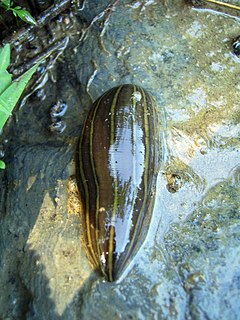Related Research Articles

Hirudo medicinalis, the European medicinal leech, is one of several species of leeches used as "medicinal leeches".

Aeromonas is a genus of Gram-negative, facultative anaerobic, rod-shaped bacteria that morphologically resemble members of the family Enterobacteriaceae. Most of the 14 described species have been associated with human diseases. The most important pathogens are A. hydrophila, A. caviae, and A. veronii biovar sobria. The organisms are ubiquitous in fresh and brackish water.

Aeromonas hydrophila is a heterotrophic, Gram-negative, rod-shaped bacterium mainly found in areas with a warm climate. This bacterium can be found in fresh or brackish water. It can survive in aerobic and anaerobic environments, and can digest materials such as gelatin and hemoglobin. A. hydrophila was isolated from humans and animals in the 1950s. It is the best known of the species of Aeromonas. It is resistant to most common antibiotics and cold temperatures and is oxidase- and indole-positive. Aeromonas hydrophila also has a symbiotic relationship as gut flora inside of certain leeches, such as Hirudo medicinalis.

Leeches are segmented parasitic or predatory worms that comprise the subclass Hirudinea within the phylum Annelida. They are closely related to the oligochaetes, which include the earthworm, and like them have soft, muscular, segmented bodies that can lengthen and contract. Both groups are hermaphrodites and have a clitellum, but leeches typically differ from the oligochaetes in having suckers at both ends and in having ring markings that do not correspond with their internal segmentation. The body is muscular and relatively solid, and the coelom, the spacious body cavity found in other annelids, is reduced to small channels.

A leech collector, leech gatherer, or leech finder was a person occupied with procuring medicinal leeches, which were in growing demand in 19th-century Europe. Leeches were used in bloodletting but were not easy for medical practitioners to obtain. The collector would sometimes gather the leeches by attracting them to the legs of animals, often old horses. More commonplace was for the collector to use their own legs, gathering the leech after it had finished sucking enough blood. Many in the profession suffered from the effects of the loss of blood and infections spread by the leeches.
Castellaniella hirudinis is a Gram-negative, rod-shaped, non-spore-forming, bacterium from the genus Castellaniella, isolated from the skin of a juvenile medical leech in Biebertal, Germany.

Hirudo is a genus of leeches of the family Hirudinidae. It was described by Carl Linnaeus in his landmark 1758 10th edition of Systema Naturae.
Hirudo orientalis is a species of medicinal leech. It has been confused with Hirudo medicinalis, but has recently been recognized as a different species. This Asian species is associated with mountainous areas in the subboreal eremial zone and occurs in Azerbaijan, Iran, Uzbekistan and Kazakhstan. It occurs also in Georgia, and probably in Armenia.
Kaistia adipata is a bacterium from the genus of Kaistia which has been isolated from soil near the Chung-Ju industrial complex in Korea.
Kaistia dalseonensis is a bacterium from the genus of Kaistia which has been isolated from river sediments from the Dalseo Stream in Korea.
Kaistia defluvii is a Gram-negative, aerobic and non-motile bacterium from the genus of Kaistia which has been isolated from river sediments from the River Geumho in Korea.
Kaistia geumhonensis is a bacterium from the genus of Kaistia which has been isolated from river sediments from the Geumho River in Korea.
Kaistia granuli is a Gram-negative, chemoorganotrophic, non-spore-forming, rod-shaped and non-motile bacterium from the genus of Kaistia which has been isolated from sludge from a wastewater treatment plant in Gongju in Korea.
Kaistia soli is a Gram-negative, strictly aerobic and non-motile bacterium from the genus of Kaistia which has been isolated from a peat layer 1200 meter above sea level in Yongneup in Korea.
Kaistia terrae is a bacterium from the genus of Kaistia which has been isolated from wetland soil from Yongneup in Korea.
Flavobacterium cutihirudinis is a Gram-negative bacterium from the genus of Flavobacterium which has been isolated from the skin of a leech Hirudo verbana from Biebertal in Germany.
Mucinivorans is an anaerobic bacterial genus from the family of Rikenellaceae with one known species. Mucinivorans hirudinis has been isolated from the digestrive tract of the leech Hirudo verbana.
Niabella drilacis is a Gram-negative and rod-shaped bacterium from the genus of Niabella which has been isolated from a leech from Biebertal in Germany.
Kaistia algarum is a Gram-negative, strictly aerobic and non-motile bacterium from the genus of Kaistia which has been isolated from the alga Paulinella chromatophora.
References
- 1 2 Parte, A.C. "Kaistia". LPSN .
- ↑ "Kaistia hirudinis Taxon Passport - StrainInfo". www.straininfo.net.
- ↑ "Details: DSM-25966". www.dsmz.de.
- ↑ "Kaistia hirudinis". www.uniprot.org.
- ↑ Glaeser, S. P.; Galatis, H.; Martin, K.; Kampfer, P. (1 March 2013). "Kaistia hirudinis sp. nov., isolated from the skin of Hirudo verbana". International Journal of Systematic and Evolutionary Microbiology. 63 (Pt 9): 3209–3213. doi:10.1099/ijs.0.049619-0. PMID 23456803.